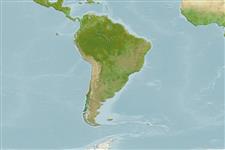Environment: milieu / climate zone / depth range / distribution range
Ecologia
marinhas; intervalo de profundidade 0 - 70 m (Ref. 54915). Subtropical; 30°S - 37°S, 74°W - 70°W (Ref. 54915)
Southeast Pacific: Coquimbo, Valparaiso and south to Talcahuano, Chile; perhaps reaches further south to Mocha Island, but more southerly records may refer to Sprattus fuegensis. Subspecies have been noted (Ref. 6698): Strangomera bentincki bentincki (Talcahuano southward) and Strangomera bentincki cuga (Valparaiso to Talcahuano).
Length at first maturity / Tamanho / Peso / Idade
Maturity: Lm 10.5, range 10 - 11 cm
Max length : 28.4 cm SL macho/indeterminado; (Ref. 27363)
Espinhos dorsais (total): 0; Raios dorsais moles (total): 13-21; Espinhos anais 0; Raios anais moles: 12 - 23. Belly not strongly keeled (Ref. 188). Body dark blue dorsally and silvery white ventrally. Fins translucent (Ref. 27363).
Occurs in schools at or near the surface in coastal waters. Feeds on plankton, especially diatoms (filter-feeding). Breeds mainly from June to November, from a length of about 10 cm. Eggs and larvae are planktonic (Ref. 52017). Mainly used for fishmeal.
Apparently releases planktonic eggs (similar to the demersal eggs of northern hemisphere Clupea).
Whitehead, P.J.P., 1985. FAO Species Catalogue. Vol. 7. Clupeoid fishes of the world (suborder Clupeoidei). An annotated and illustrated catalogue of the herrings, sardines, pilchards, sprats, shads, anchovies and wolf-herrings. FAO Fish. Synop. 125(7/1):1-303. Rome: FAO. (Ref. 188)
Categoria na Lista Vermelha da IUCN (Ref. 130435)
Ameaça para o homem
Harmless
Utilização humana
Pescarias: altamente comercial
Mais informação
ReferênciasAquaculturaPerfil para aquaculturaEstirpesGenéticaElectrophoresesHereditariedadeDoençasProcessamentoNutrientsMass conversion
ColaboradoresFotografiasStamps, Coins Misc.SonsCiguateraVelocidadeTipo de nataçãoÁrea branquialOutras referênciasCérebrosVisão
Ferramentas
Relatórios especiais
Descarregue XML
Fontes da internet
Estimates based on models
Phylogenetic diversity index (Ref.
82804): PD
50 = 1.0000 [Uniqueness, from 0.5 = low to 2.0 = high].
Bayesian length-weight: a=0.00603 (0.00346 - 0.01050), b=3.09 (2.93 - 3.25), in cm total length, based on LWR estimates for this species & (Sub)family-body (Ref.
93245).
Nível Trófico (Ref.
69278): 2.7 ±0.30 se; based on food items.
Resiliência (Ref.
120179): Elevada, tempo mínimo de duplicação da população menor que 15 meses (K=0.6).
Prior r = 1.11, 95% CL = 0.73 - 1.67, Based on 1 stock assessment.
Fishing Vulnerability (Ref.
59153): Low to moderate vulnerability (26 of 100).
Climate Vulnerability (Ref.
125649): Very high vulnerability (88 of 100).
Nutrients (Ref.
124155): Calcium = 134 [74, 232] mg/100g; Iron = 1.83 [1.01, 3.14] mg/100g; Protein = 19.4 [18.3, 20.5] %; Omega3 = 0.567 [0.348, 0.939] g/100g; Selenium = 23.8 [12.8, 46.2] μg/100g; VitaminA = 9.87 [3.19, 27.55] μg/100g; Zinc = 1.09 [0.75, 1.59] mg/100g (wet weight);
